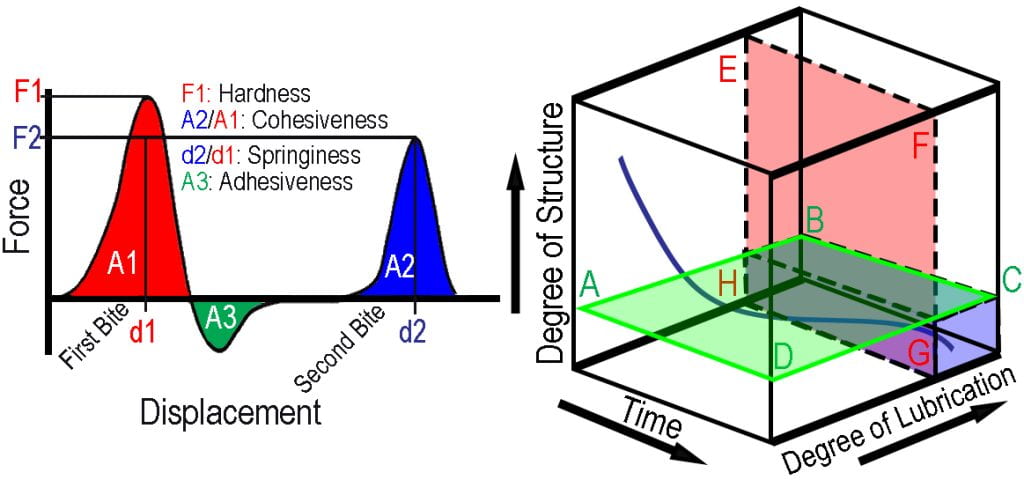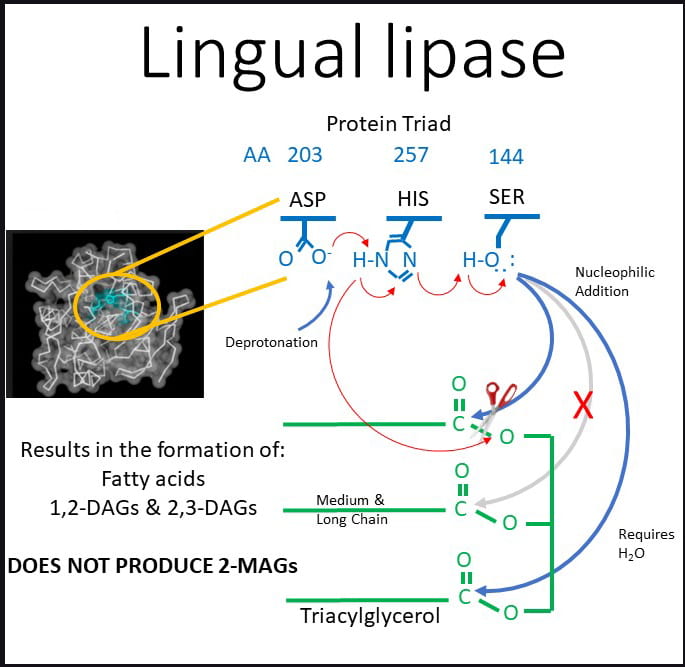Mouth Process Model
Digestion is initiated in the oral cavity with the first bite and involves numerous operations, including the incorporation of saliva containing mucin and salivary amylase, chewing, mastication, bolus formation, and swallowing (Chen, 2009). Oral food processing is typically characterized using force-displacement diagrams of a double compression test, where the first compression represents the first bite, and the following compression emulates successive bites. Textural features of foods sensed in the oral cavity include hardness, elasticity, adhesiveness, brittleness, chewiness, and gumminess, each altering the force-displacement diagram uniquely. The hardness of the food is characterized by force required during the first bite (F1), while each subsequent bite (F2) requires less force due to the loss of structure. Following the first bite, adhesion represents the force required to separate teeth (A3). Food cohesiveness is characterized by the ratio of the area of the second bite divided by the area of the first bite (A2/A1), while springiness is the ratio of displacements (d2/d1).
While food resides in the oral cavity before swallowing, two primary operations occur concurrently, degradation of structure and incorporation of saliva to increase lubrication. The incorporation of mucin destabilizes and induces flocculation of emulsions, while salivary amylase initiates starch digestion. The oral food process model (Chen 2009) suggests that before swallowing, the structure must be degraded below the ABCH plane, and lubrication has to increase above the EFGH plane. Hence before food can be swallowed, the structure must be degraded and lubricated to form a bolus adequate for swallowing (lower back blue region beyond the BCHG plane). The blue line represents the path followed by a portion of food during chewing and before swallowing.

Saliva
Saliva, secreted from salivary glands in the oral cavity, is an extracellular fluid comprised mostly of water (99.5%), electrolytes, mucin and other minor compounds. Saliva is essential for digestion; as the food particle size is reduced, saliva mixes with the bolus until it is lubricated enough to swallow. The primary enzymes secreted alongside saliva are amylase and lipase (outlined below). Mucin contains glycosaminoglycans, linear polysaccharides of a repeating disaccharide of a uronic sugar and an amino sugar, and glycoproteins, an oligosaccharide covalently bonded to amino acid R-group (side chain). In addition to lubrication, when glycosaminoglycans and glycoproteins are mixed with foods, other structural changes occur, including emulsion destabilization and flocculation, altering the rate of subsequent lipolysis further along the GI.
Lingual and Maternal Lipases

Lipid hydrolysis is initiated in the oral cavity as lingual lipase is secreted. Unlike pancreatic lipase, lingual lipase is acid stable, does not require bile or co-lipase, and preferentially cleaves medium-chain triglycerides at the SN1 or SN3 positions, generating one free fatty acid and either 1,2- or, 2, 3-diacylglycerol. Lingual lipase relies on the aspartate, histidine, and serine catalytic triad located in the primary protein sequence at 203, 257, and 144. Human lipase, for the most part, cannot cleave SN2 fatty acids from triglycerides; the exception is maternal Iipase in breast milk.
Lingual lipase remains active in the acidic gastric environment and small intestine; however, the proportion of lipid digestion completed by lingual lipase is low (~10%) in healthy adults. Also important for lipid digestion in the oral cavity is the incorporation of mucin, as it destabilizes oil-in-water acid-stable emulsions. Lingual and material lipases (contained in breast milk) play a more significant role in pediatric nutrition (Freed, 1989). Human milk contains two lipases, bile salt-stimulated lipase (BSSL) and lipoprotein lipase (LPL). LPL does not play a significant role in pediatric lipolysis but hydrolyzes milk fat during cold storage. BSSL Maternal lipase found in breast milk remains active and stable to a pH of 3.5, above the gastric acidity of newborns resisting denaturation before it can transit into the small intestine as it requires bile acids to become active in the duodenum. As material lipase is responsible for a significant role in lipid digestion in newborns; thus it is important to preserve the activity BSSL lipase in donor breast milk as it is typically pasteurized, which can denature the enzyme rendering it inactive (Koh, 2020).
Salivary Amylase
Amylase, the enzyme responsible for hydrolyzing polymeric carbohydrates, is predominantly produced by the salivary glands and the pancreas and encoded by AMY1 and AMY2 genes. Proteins in saliva are geared toward metabolic and catabolic processes, unlike plasma proteomes (des Gachons, 2016). α-amylase is the primary digestive protein found in saliva and enables D-(1,4) glycosidic bonds but not D-(1-6) to be cleaved, initiating carbohydrate digestion. α-amylase cleaves digestible carbohydrates such as starch into dextrins, isomaltooligosaccharides containing intact α-D-(1,6) linkages, the trisaccharide maltotriose, and the disaccharide maltose – the smallest sub-unit formed by α-amylase. Maltose is cleaved into two glucose units by the brush border enzyme, maltase, found in the small intestine. Salivary amylase plays a minor role in digestion due to the short contact time with starch before the bolus is acidified in the stomach, inhibiting catabolic activity. Most of the starch occurs via the action of pancreatic amylase, which is released into the duodenal portion of the small intestine.
AMY1 copy number is higher in populations where ancestors consumed diets rich in starch, suggesting a directional selection toward higher salivary amylase for starch digestion. The copy number variation (CNV) of the AMY1 gene ranges from 2-17 gene copies; individuals with higher AMY1 CNV produce more enzymes than those with lower AMY1 CNV. Copy variant for the AMY2 (pancreatic amylase) is limited from 2-6 typically. Interestingly obligate carnivores Such as dogs tend only to produce pancreatic amylase as they only contain the AMY2 gene and not AMY1.
Cephalic Response and Origins Of Condition Responses

As described in the gut-brain axis, hunger concurs with the cephalic response, triggered by the thought, smell, or sight of food, communicating to the gastrointestinal tract through the vagus nerve to prepare to receive food by causing the release of gastrin acts on the chief and parietal cells to release the inactive zymogen (pepsinogen) and HCl.
As part of the cephalic response, salivary secretions increase; remarkably, prior to Ivan Pavlov’s experimentally proven theory of conditioned reflexes using surgical fistulas to study the salivary glands of dogs’ psychic salivary secretion was the school of thought. Pavlov’s 1904 Nobel Prize in medicine for developing the surgical use of fistulas to study functions of various organs showed that the nervous system plays the dominant part in regulating the digestive process, initiating a path for our modern understanding of the physiology of digestion while discovering that reflex mechanisms were not of psychic activity but instead conditioned reflexes.
Works Cited
Chen, J. (2009). Food oral processing-A review. Food Hydrocolloids, 23, 1-25.
des Gachons, C.P. et al., (2016) Salivary Amylase: Digestion and Metabolic Syndrome. Current Diabetes Research. 16: 102
Freed, L.M. et al., (1989) Lipases in human milk: effect of gestational age and length of lactation on enzyme activity. Journal of the American College of Nutrition. 8: 143-150.
Koh et al. (2020) Bile Salt-Stimulated Lipase Activity in Donor Breast Milk Influenced by Pasteurization Techniques. Frontiers in Nutrition. 7: 552362.


